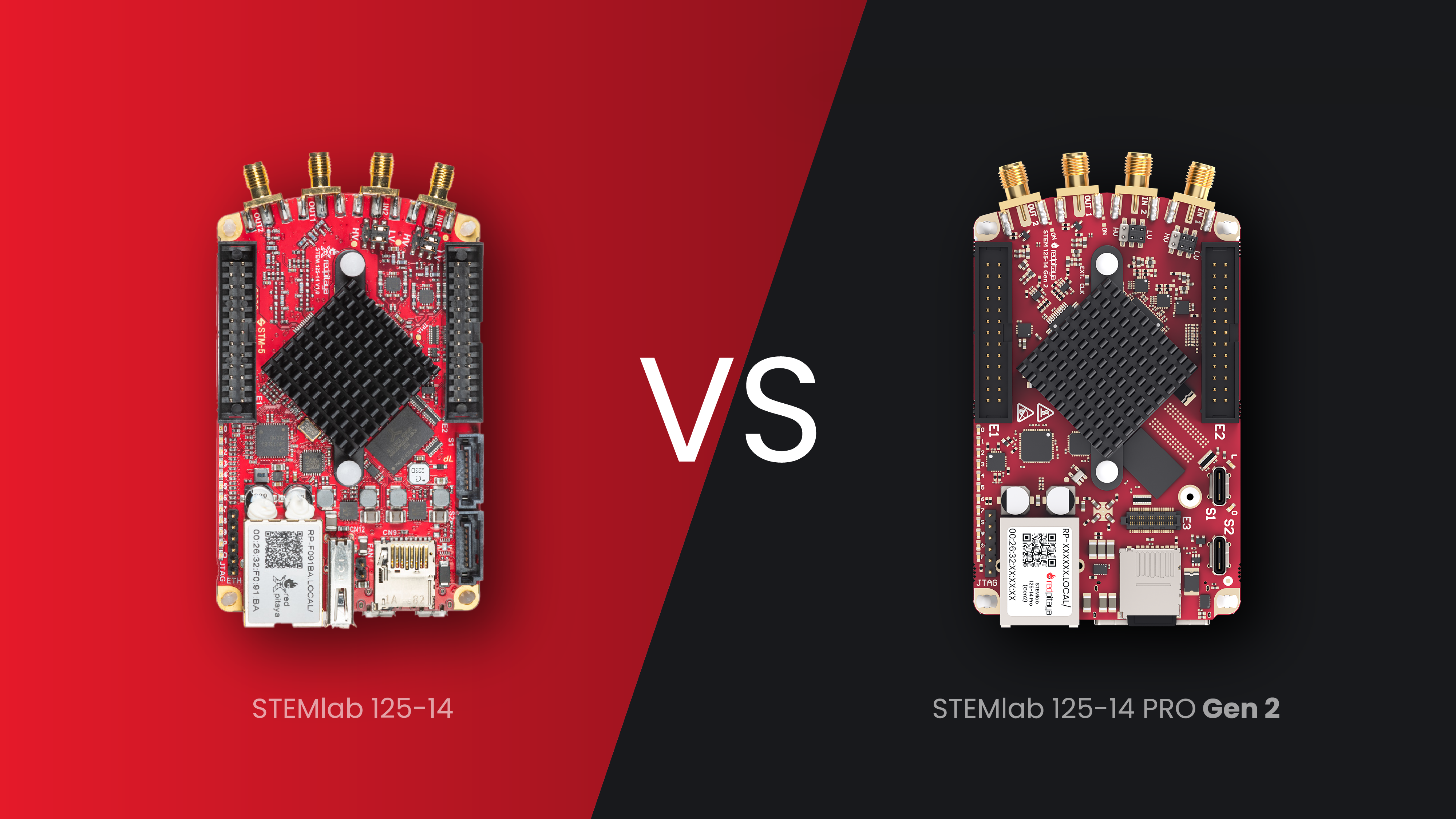Evolving the Platform: Comparing the Original STEMlab 125-14 to Gen 2
-
Posted by
 Red Pitaya Team
, July 23, 2025
Red Pitaya Team
, July 23, 2025

When we set out to develop Gen 2, our goal was simple: keep everything that made the STEMlab 125‑14 great—same board size, same connectors, full software and FPGA compatibility—while significantly improving performance and reliability for real-world engineering use.
The STEMlab 125‑14 Gen 2 series brings enhanced performance to the original STEMlab platform, featuring a revamped analog front end, modern USB‑C connectivity, and firmware-selectable QSPI/eMMC boot options on Pro models. Available in three versions, the Gen 2 line supports use cases ranging from teaching labs and makerspaces to synchronized industrial test benches and real-time, high-channel-count DSP. An optional QSPI/eMMC Boot Module adds safe-shutdown sequencing, and sixteen fast GPIOs are exposed on the E3 connector—no module required—all controlled via open-source firmware.
Gen 2 Design Goals and Key Enhancements
Enhanced Analog Performance
SFDR Improvement
Increased from 40 dB to 50 dB at 10 MHz / 10 dBm, delivering significantly cleaner spectra.
Crosstalk Reduction
Reduced crosstalk from 55 dB to 70 dB up to 30 MHz, minimizing measurement interference.
Noise Floor & Ranges
Lowered the overall noise floor while preserving the familiar ±1 V full-scale range into 50 Ω and ±2 V into high-impedance mode—ensuring compatibility with existing probes and accessories.
Flexible Boot & Robust Power Management
E3 Connector
Exposes QSPI flash, eMMC storage, and watchdog-under-clock interfaces for firmware-controlled boot selection—no manual media swaps required.
Safe Shutdown
An onboard STM32 microcontroller manages single-button on/off control, a hardware watchdog, and orderly shutdown to protect filesystems in the event of power interruptions.
Scalable FPGA & Memory Configurations
Gen 2: Xilinx Zynq 7010 with 512 MB DDR3, suitable for general-purpose signal generation and acquisition.
PRO Gen 2: Same SoC and memory, with the addition of the E3 boot/I/O extension for industrial applications.
PRO Z7020 Gen 2: Xilinx Zynq 7020 with 1 GB DDR3—offering roughly three times the FPGA fabric and twice the RAM—geared toward complex, real-time DSP and analytics workloads.
Modern Connectivity & Precise Synchronization
USB‑C Power & Data
Includes two USB‑C data ports plus a dedicated USB‑C power port delivering up to 5 V / 3 A, simplifying cabling and supporting modern USB‑C power supplies.
Clock Selection
External reference via SMA or internal 125 MHz oscillator—selection managed through pins on the E2 connector.
Multi‑Unit Sync
Built-in header and USB‑C daisy-chaining capability support synchronized operation, ideal for phased-array and MIMO setups.
QSPI eMMC Boot Module Overview
The optional Boot Module Gen 2 plugs into the PRO boards’ E3 connector to provide:
Power Sequencing: STM32‑driven single‑button ON/OFF, hardware watchdog, and safe shutdown to prevent storage corruption.
Boot Media Flexibility: Firmware‑selectable boot from microSD, QSPI flash, or high‑speed eMMC for faster, more reliable startups.
Open‑Source Firmware: Preloaded Arduino IDE C++ code, fully modifiable for bespoke power and boot logic.Gen 2 extends the STEMlab 125‑14 platform into a flexible, software-defined instrumentation system by combining enhanced analog fidelity, modern USB‑C connectivity, flexible boot and power sequencing, scalable FPGA resources, and precise synchronization—all within a backward-compatible package. The optional QSPI/eMMC Boot Module adds safe-shutdown sequencing under open-source firmware control, enabling engineers to confidently address applications across education, research, and industry—without compromise.
About the Red Pitaya Team
The Red Pitaya editorial team consists of engineers, researchers, and product experts who develop and test cutting-edge open-source test & measurement solutions.
Our mission is to make advanced instrumentation accessible to everyone — from students and educators to leading research labs worldwide.



